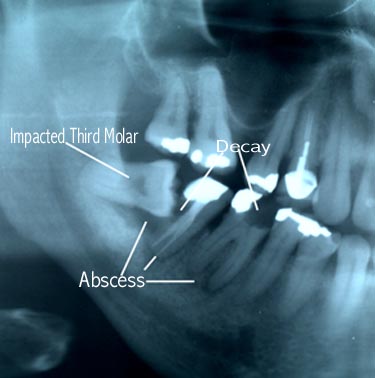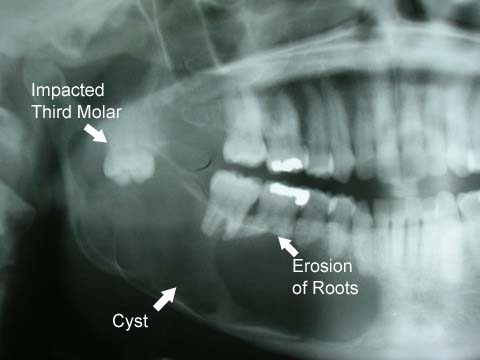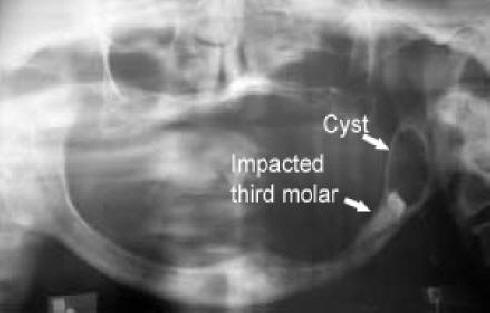Impacted teeth
What is an impacted tooth?

An impacted tooth is one which has not come into the mouth by the time it would be expected to have. In other words it is stuck. The most common reason for a tooth to become impacted is lack of space. Other reasons may include cysts and tumors associated with the tooth, fusion of the tooth to the surrounding bone or nearby teeth, or in some instances for unknown reasons a tooth just fails to complete its movement into the mouth.
Which teeth become impacted and why?
The tooth most likely to become impacted is the wisdom tooth, or third molar. These teeth are the third set of permanent (adult) molars. They are called wisdom teeth because they are supposed to enter the mouth by the "age of wisdom," roughly eighteen years of age. Hence why they are also know as the "eighteen year molars," in contrast to the first or six year molars and the second or twelve year molars. Wisdom teeth are not only the most likely teeth to be impacted, but also the most likely to be deformed, missing or present in extra numbers. Most people have four wisdom teeth: upper right and left and lower right and left. Some people are missing one or more wisdom teeth and others have extra sets (as many as quadruple, in my experience).
Other commonly impacted teeth are the cuspids or
"canines," also known as "fang" or "eye" teeth and premolars
(the teeth just behind the cuspids). Often when people
have extra teeth, these are often impacted. Any tooth can
become impacted if it does not have enough room or if the timing
of it development is out of synch with the rest of the teeth.
Since many people do not have enough room for all of their teeth
to come in, the one most likely to be stuck or impacted is the
last one to form, the wisdom tooth. The other teeth had used up
the available space as they came into the mouth. When a person
has crowded teeth, the wisdom tooth may have even less space
available after the rest of the teeth are straightened. Not all
people have impacted wisdom teeth, some people do have enough
room for their wisdom teeth.
Many theories have been proposed to try to explain why so many
people do not have enough room for all of their teeth,
especially for the wisdom teeth. The most popular has been that
our jaws have been getting smaller as humans have developed.
However, studies done on ancient and modern skulls do not
support this idea. What these studies do show is that in our
ancestors, before modern dental care was available and to a
lesser degree even today, the most commonly missing or decayed
tooth is the first or six year molar. By the time that the
wisdom tooth was ready to start to enter the mouth it might have
had enough room in our very distant ancestors. Records of
drafted and recruited US personnel during World War II showed
that, with an average age of 19 years, that group was missing
almost half of his or her teeth.
The wisdom tooth is not the only tooth that may become impacted.
Other teeth that are often impacted include the canine or eye
teeth, the premolars or bicuspids (small molar like teeth behind
the eyeteeth) and extra teeth. However, any tooth may
become impacted if it does not enter the mouth on time or is in
some way blocked.
What, if anything needs to be done?
Does anything need to be done for an impacted tooth? The answer depends on a few things. First, if there is enough room and the tooth is an important one for function or cosmetics, then if possible, an attempt is made to bring the tooth into position with a combination of surgery and orthodontics (braces). This is commonly done for impacted canine or eyeteeth. If the tooth does not have enough room, is an extra tooth or is deformed, often it needs to be removed.
What happens if nothing is done?

Large cyst associated with impacted third molar, displacing it and eroding roots of teeth.
Sometimes the answer is nothing, for a while anyway. Nothing may
happen for years. If the tooth persists on trying to come into
the mouth it may push against the nearby teeth and damage them.
If the gum opens up enough over an impacted tooth to allow
bacteria from the mouth to enter the space around the impacted
tooth, it may become infected. Depending on the type of
bacteria, several problems may develop.
An impacted tooth may cause difficulties with proper tooth
cleaning and allow plaque (which is full of bacteria) to
accumulate. This may lead with time to periodontal (gum) disease
and spread to the nearby teeth. Other types of bacteria may
cause tooth decay. The wisdom tooth or a nearby tooth may become
decayed. Less commonly, the sack of tissue that surrounds the
wisdom tooth may start to enlarge and fill up with fluid,
forming what is called a cyst. A cyst may continue to grow and
damage the jawbone, nearby teeth or other structures. This sack
may also form tumors or growths. Although most of these are
benign (and may still grow like the cysts) some may rarely be
malignant (cancer).
Delaying treatment may also place the nearby teeth at risk. Many
patients come in to have a wisdom tooth, or other impacted
tooth, removed because of pain, but many times a tooth adjacent
to it is so badly damaged that it is the one that hurts or it
may even be beyond repair and be lost. Sometimes a wisdom tooth
may not cause problems until the person is much older, as old as
the nineties in my experience. That is definitely not a good age
to be having wisdom teeth removed.
When is the best time to do something?

Most of the problems with impacted teeth tend to develop with
time. However, the best time to treat these teeth is before the
problems develop. If a tooth has enough room and is to be
brought into the mouth, there is a limited window of time to do
this. As time passes, the tooth becomes harder and harder to
move until it loses the ability to move. If a tooth does not
have enough room, the best time to remove it is before it causes
problems (infection, gum disease, decay, damage to other teeth,
etc.) but before it finishes its development.
In theory, an impacted tooth closer to the surface could be
easier to remove. But, in reality, the structures that anchor a
tooth in the jaw are the surrounding bone and the roots, not the
gum that covers it. Many wisdom teeth at the surface have
proven to be some very difficult teeth to remove. The more
mature and harder the bone and the more developed and longer the
roots, the harder the tooth becomes to remove. A common mistake
is to wait for the tooth to come in more, hoping that it becomes
easier to remove. The easiest time to remove a wisdom tooth is
when the roots are about half to three quarters formed.